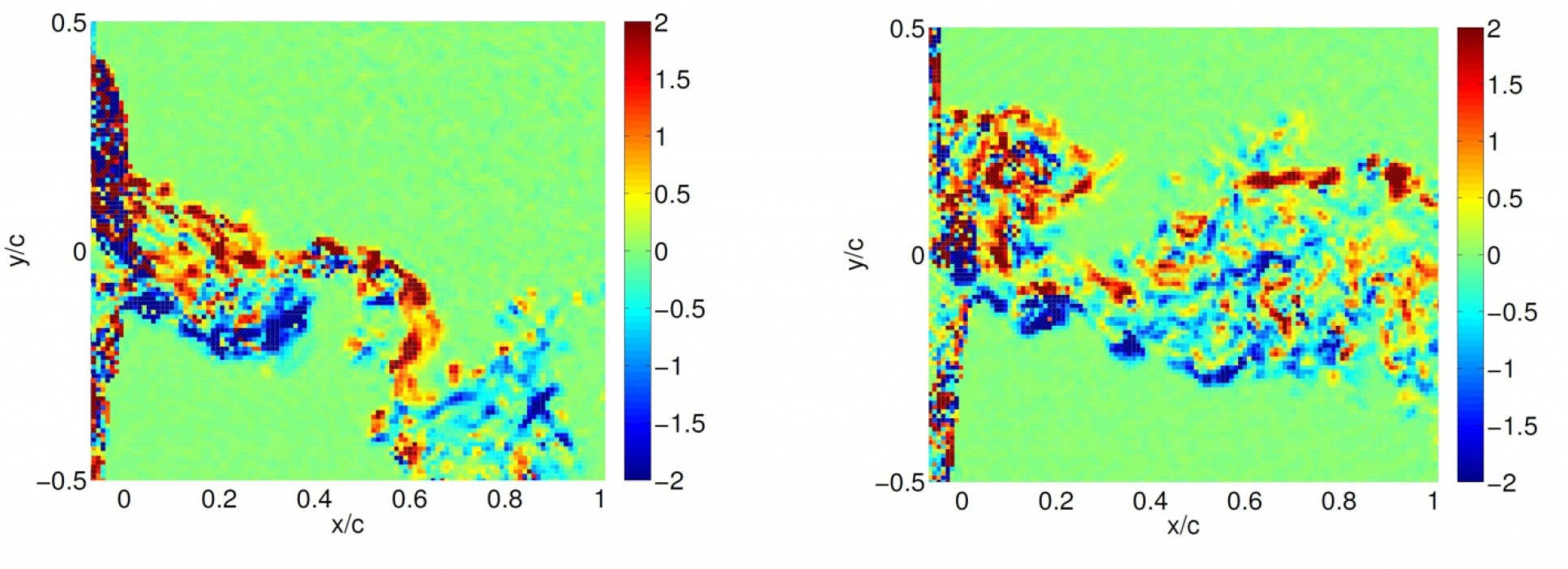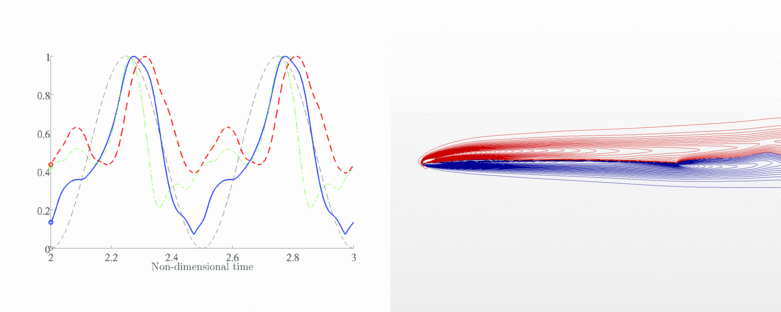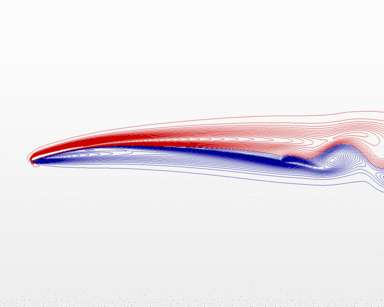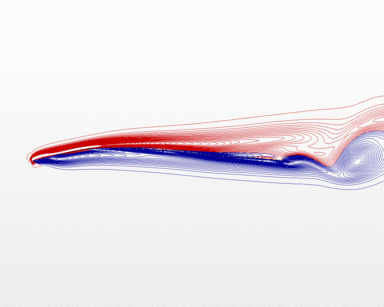Current technology of smart actuators and compliant structures finally allows for conformable wings for application to micro air vehicles. High wing flexibility is critical to achieve high maneuverability and control of flow separation.
Nature is often the source of inspiration in these applications, as the extremely high energy effciency of natural fliers and swimmers is achieved with highly deformable surfaces. However, wing adaptation is obtained in part by a reduction of stiffness in the wing primary structures, and this may also have an big impact in the aeroelastic stability characteristics, which makes studying this problem particularly challenging. We investigate means of incorporate integral actuation into the membranes for enhanced aerodynamic performance. Additional interest in this area include energy harvesting devices that exploit wind-induced vibrations of flexible structures with embedded electromechanical transducers.

Past projects
High-fidelity optimization of actuated membrane wings
Investigators: Ruben Sanchez (link to PhD thesis)
Membrane wings offer the prospect of extraordinary performance characteristics for small air vehicles -- if we only knew how to actuate them as bats do. To address this, in this project we aim to explore the potential of embedded electromechanical systems on membrane wings to achieve on-demand aerodynamic performance. This will first the development of computational multiphysic models that capture the complex dynamic interactions between electric, elastic and fluid fields on highly-deforming geometries. Our results show the potential for this technology to allow controllable outdoors flight of very small fixed-wing air vehicles.
Aeromechanics of actuated membrane wings
Investigators: Dr Stefano Buoso (link to PhD thesis)
Membrane wings offer the prospect of extraordinary performance characteristics for small air vehicles -- if we only knew how to actuate them as bats do. To address this, in this project we aim to explore the potential of embedded electromechanical systems on membrane wings to achieve on-demand aerodynamic performance. This will first require the development of computational multiphysic models that capture the complex dynamic interactions between electric, elastic and fluid fields on highly-deforming geometries. Then, reduced-order models are built from which control systems can be derived. Our results have shown the potential for this technology to allow controllable outdoors flight of very small fixed-wing air vehicles.
Effect of membrane compliance
The high-fidelity model allows the investigation of wing desing parameters, like the prestretch, which influence the way the structure and the fluid interact. Fig. 1a and 1b show the vorticity contour plots around a membrane wing for compliant and very stiff conditions . Larger prestretch values determine a stiffer structure, with smaller deformations and a faster shedding of vortices.
| Fig. 1a - Membrane wing, prestretch = 1.02 | Fig. 1b - Membrane wing, prestretch = 2.0 |
|---|---|
 |
 |
| Vorticity contour for Re = 2500, α = 8°. Membrane material : VHB4905 (credit: Dr Stefano Buoso) | |
Effect of material modelling assumptions
Rate-depentent effects can play a major contribution into the dynamics of dielectric elastomers. The aeroelasitc model has been used to asses their impact into the final aeroelastic response of the system. The main findings show that rate-dependent effects can significantly alter the dynamic response of the wing. Fig. 2a and 2b compares the unsteady flow response around DE membranes under hyperelastic and viscoelastic material assumptions.
| Fig. 2a - Membrane wing, prestretch = 1.02, hyperelastic constitutive model | Fig. 2b - Membrane wing, prestretch = 1.02 viscoelastic constitutive model |
|---|---|
 |
 |
| Vorticity contour for Re = 2500, α = 8°. Membrane material: VHB4905 (credit: Dr Stefano Buoso) | |
Effect of integral actuation on system dynamics
The model has been used to assess the authority of integral actuation through embedded dielectric elastomers as membrane wing material. Fig. 3 shows the time evolution of lift and drag coefficients (red and green, respectively), maximum membrane amplitude (blue) for an harmonic input of the voltage (black line). The time evolutions are normalised with their maximum values. The figure also shows the vorticity evolution around the actuated wing. As a results of the integral actuation, the membrane shows an increase of 10% of the mean lift-to-drag ratio. Numerical results for both the hyperelastic and viscoelastic material assumptions found good coorrelation with the experimental results in the literature. Click here for more results.
| Fig. 3 Integral actuation of membrane wing - 4 Hz |
|---|
 |
| Vorticity contour for Re = 2500, α =4°, with excitation at 4 Hz and integral actuation. Membrane material: VHB4905 (credit: Dr Stefano Buoso) |
The aeroelastic model allows to capture the different flow structures that are generated by different actuation frequencies and voltages. Fig. 4a and 4b shows the vorticity field around the wing actuated with voltage signals at 6 Hz and 8 Hz, respectively. The flow structures are significantly different from the ones in Fig. 3 due to the interaction of the fluid with higher membrane modes. The final performance, in terms of variation of the mean lift coefficient, are shown in Fig.5.
| Fig. 4a - Actuation at 6 Hz | Fig. 4b - Actuation at 8 Hz |
|---|---|
 |
 |
| Vorticity contour for Re = 2500, α =4° and integral actuation. Membrane material: VHB4905. | |
Aeromechanical Performance of Compliant Aerofoils
Main investigator: Sara Arbos (link to PhD thesis)
This project examined the dynamic response of membrane as well as composite-flexible aerofoils. Emphasis was on the effect of the geometry of leading and trailing edge supports, which are necessary to attach such very flexible wings on an actual vehicle. A variety of diagnostic methods including photogrammetry, unsteady lift and drag force measurements, wake measurements using hot-wire anemometry and Particle Image Velocimetry was utilised to isolate the cause and effect relationships of the dominant unsteady effects. The conjunction of hot-wire results with photogrammetry imagery of the membrane deformation indicates that the membrane vibration is coupled with the vortex shedding.
For low angles of attack the wake characteristics are highly affected by the leading- and trailing-edge geometry; as incidence increases the wake characteristics become less dependant on the support’s geometry, eventually reaching a point in which they are fully independent of it and closely resembling a fully stalled rigid aerofoil. The results of this study should provide valuable insight for future use of membrane wings in micro air vehicles
Contact us
Room 338, City & Guilds Building
South Kensington Campus
Imperial College, London SW7 2AZ
Email: r.palacios@imperial.ac.uk
Tel: +44 (0)20 7594 5075